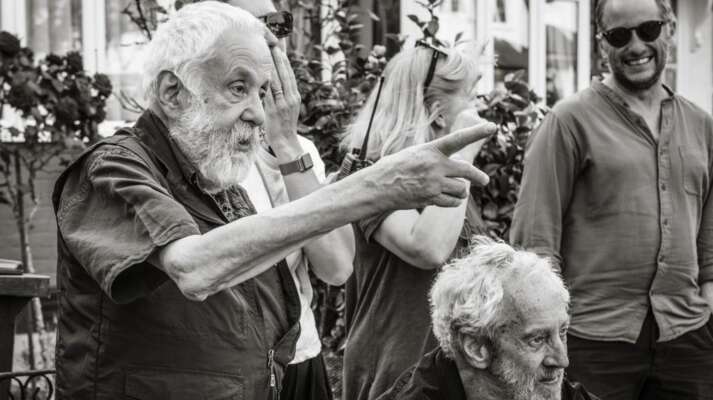Filmmakers We Love: Jim Jarmusch
A look at Jim Jarmusch’s groundbreaking films, from Stranger than Paradise to PATERSON.
Filmmakers We Love: Jim Jarmusch
Written By Peter Bowen
PATERSON | The Poetry of Details
In Jim Jarmusch’s PATERSON, Adam Driver plays Paterson, a bus driver who lives in Paterson, NJ, with his wife, Laura (Golshifteh Farahani), and their bulldog Marvin. The film follows Paterson over the course of a week––having breakfast, driving his bus, writing poems, and taking Marvin for a walk to his favorite bar. All the time, Paterson marvels at the strange and wondrous world that lays all about him, from the keen-witted conversations conducted by the people on his bus (like those of Moonrise Kingdom stars Kara Hayward and Jared Gilman) to the shrine to the city’s favorite sons and daughters created by the local bartender, Doc (Barry Shabaka Henley), to the impromptu raps of Method Man in a local laundry mat. For Jarmusch, “PATERSON is intended as a celebration of the poetry of details, variations and daily interactions and a kind of antidote to dark, heavily dramatic or action-oriented cinema. It’s a film one should just allow to float past them—like images seen from the window of a public bus, moving like a mechanical gondola through a small, forgotten city.” For critics, the film’s simplicity highlights the richness of Jarmusch’s vision. “A wistful, but not downbeat, meditation on poetry and place, PATERSON is one of the more loving film depictions of a small American city in recent memory,” extols Vanity Fair’s Richard Lawson. And Chicago Reader’s Jonathan Rosenbaum adds, “Like many of Jarmusch's best films, this keeps surprising us with its minimal, witty inflections, at once epic and small-scale.” While wholly original, PATERSON nevertheless echoes and refines many themes and ideas that populate Jarmusch’s filmography. From the reciting of Robert Frost (in Italian) in Down By Law to the references to William Blake in Dead Man, an appreciation for poetry (both textual and visual) threads its way through nearly all of Jarmusch’s film. And as a portrait of a man living in a small New Jersey city, PATERSON is certainly a stop on the journey Jarmusch began more than 30 years ago in Stranger than Paradise, a quest that has taken him through the indelible landscapes and unforgettable characters that make up the American psyche.
Stranger than Paradise | States of Wonder

If Jim Jarmusch’s 1984 black-and-white second feature Stranger than Paradise now stands as a landmark of American independent cinema, its production also bears witness to the filmmaker’s determination and ingenuity. After making his NYU thesis film, Permanent Vacation, in 1980 for $12,000, Jarmusch took a pragmatic approach to securing the financing for Stranger Than Paradise. To get him started, German filmmaker Wim Wenders gave Jarmusch leftover stock from Lightning Over Water, his film about director Nicholas Ray, for whom Jarmusch was also working as his personal assistant at the time. That stock was used to shoot a 30-minute movie, which Jarmusch and his producer, Sara Driver, used to raise the additional $100,000 they needed to create his feature. The short film, entitled “The New World,” would become the first third of Stranger Than Paradise. Using a three-act structure, Jarmusch follows the misadventures of three people: Willie (John Lurie), Eddie (Richard Edson), and Willie’s cousin Eva (Eszter Balint), who has just come over from Hungary. Each section finds the trio stuck in a different state (New York, Ohio, and Florida), although each with a stark black-and-white landscape that looks uncannily like the others. This vision of America, at once bleak, poetic, funny, and alien, perfectly illustrates Jarmusch’s aesthetic, one in which the parts always feel larger than the whole. “Rather than finding a story that I want to tell and then adding the details, I collect the details and then try to construct a puzzle or story,” Jarmusch describes about his creative process. For critics, the film proved a revelation. The New Yorker critic Pauline Kael compared Jarmusch’s minimalist approach to high modernist drama, noting its style recalls “something of the effect of Samuel Beckett's pauses: they make us look more intently, as Beckett makes us listen more intently.” At the Cannes Film Festival, Stranger than Paradise won the Caméra d'Or award for debut films and then the Golden Leopard at the Locarno International Film Festival. Later that year it was awarded the National Society of Film Critics Award for Best Picture of 1985. When it was released, it also proved a small, but significant, box office success, one that would make the film’s production model a blueprint for aspiring filmmakers for generations to come. And Jarmusch’s insistence on complete creative control would make him an enduring example of how to be an independent film director. In 1997, Entertainment Weekly named Stranger Than Paradise as one of the “50 Greatest Independent Films.”
Down By Law | A Sad and Beautiful World

In his 1986 film Down By Law, Jim Jarmusch continues his exploration of the American psyche, but this time by restricting his focus to one city, New Orleans. In this “neo-beat-noir-comedy,” as Jarmusch describes it, the lives of three unlikely characters become temporarily intertwined when they all end up in a New Orleans prison. The comedy’s cosmic joke is that the two lowlifes—an out-of-work DJ, Zach (Tom Waits), and a pimp, Jack (John Lurie)––have been set up, while the ebullient, fish-out-of-water Italian tourist, Bob (Roberto Benigni), is actually guilty. In taking on the genre of comedy, Jarmusch twists its conventions to fit his particular aesthetic. “I am tired of the cinema of despair and existential angst,” Jarmusch explains in Emanuel Levy’s Cinema of Outsiders: The Rise of American Independent Film. “I’m interested in comedy in a new context. Not just sight gags. Not just linguistic jokes. But humor based on small details, things from daily life that are funny.” Following the three-act structure set up in Stranger than Paradise, Down by Law moves from the New Orleans city streets to the Orleans Parish Prison, ending up in the bayous around the town of Slidell in the final act. In the DVD commentary, Jarmusch notes, “There's a certain mystique about New Orleans…It really is a country unto itself, a culture unto itself.” The film, luminously shot in black and white and deep focus by German cinematographer Robbie Müller, presents the city with unexpected lyricism. At one point, Benigni in broken English calls the city a “sad and beautiful world,” a line that was supposed to read as “sad and beautiful song.” Jarmusch kept the line because it fit the tone so perfectly. The Best of New Orleans later wrote that Down By Law “may have captured New Orleans better than any other film.” For critics, the film’s haunting beauty affirmed that Jarmusch was one of the most original filmmakers working in America. As The New York Times’ Vincent Canby writes, “The excitement of Down by Law comes not from what it's ‘about.’ Reduced to its plot, it is very slight. But the plot isn't the point. The excitement comes from the realization that we are seeing a true filmmaker at work, using film to create a narrative that couldn't exist on the stage or the printed page of a novel.”
Dead Man | Into The Past

In his 1995 Dead Man, Jim Jarmusch takes his journey to the heart of America by visiting its past. Set some 120 years ago, William Blake (Johnny Depp), an accountant from Cleveland, travels west for a potential job in the frontier town of Machine. But rather than securing employment, Blake runs into all sorts of trouble, being run off by the town’s oligarch, John Dickinson (Robert Mitchum), having an affair with (and then witnessing the death of) a local prostitute (Mili Avital), and killing the son of John Dickinson (Gabriel Byrne). Finally Blake, wounded and scared, flees the town before being befriended by a Native American guide named Nobody (Gary Farmer), who sees in him the spirit of the English mystic poet, William Blake. While pursued by a trio of bounty hunters, Blake is pushed towards a vision quest, a final journey into the undiscovered country from which, as Hamlet says, “no traveler returns.” Dubbed by Jarmusch as a “psychedelic Western,” the film is at once fantastic in its hallucinatory tone and precise in its meticulous attention to Native American history. For many critics, Dead Man’s ability to picture a West as yet unfiltered by the machinery of American movies and history is one of its great triumphs. In Salon, critic Greil Marcus gives “10 reasons why Dead Man is the best movie of the end of the 20th century,” with one being its “sense of an undiscovered West—a West that vanished before it could be incorporated into national myth.” Even Jarmusch’s characters, people with little idea of a future or past, embody the opposite spirit of manifest destiny. Jarmusch tells the Harvard Crimson,"Johnny's character starts out very mild-mannered, but he's such a blank piece of paper that people want to write all over it.” Dead Man went on to receive four Spirit Award nominations, including Best Feature and Best Screenplay.
Ghost Dog: The Way of the Samurai | Order in Chaos

In his 1999 film, Ghost Dog: The Way of the Samurai, Jim Jarmusch uses the martial arts genre to lay bare the complex intersection of cultures that make up America today. The film’s hero, Ghost Dog (Forest Whitaker), is a hit man who lives by the code of the Samurai, but is employed by a local gangster, Louie (John Tormey), to whom he is forever indebted for having saved his life once. His unique life as a spiritual assassin comes to a sudden end when he refuses to kill an innocent witness. After his bosses decide it would better to wipe out their killer than leave any loose ends behind, Ghost Dog finds himself single handedly waging war against the mob. And he would take out the whole gang, if honor did not forbid him from harming the one man who rescued him. But far from being a fast-paced action film with slow-motion fight scenes, Ghost Dog’sreal focus is on the fascinating, eclectic world that surrounds its hero—a Haitian ice-cream salesman (Isaach De Bankolé), a Kayuga Indian pigeon handler (Gary Farmer), a book-loving little girl named Pearline (Camille Winbush), and the “Camouflage Samurai” (played by the Wu-Tang Clan’s RZA, who also scored the film). “We're a culture made up of people from other cultures that have mixed together,” Jarmusch told the A.V. Club. “I love being aware of where these things come from and having some sense of cultural identity, but I also look forward to them mixing together.” Highlighting its melted-pot sensibility, Jarmusch labeled Ghost Dog “a gangster samurai hip-hop Eastern western.” Creatively Jarmusch drew on literary traditions as diverse as Don Quixote, Frankenstein, American pulp thrillers, like Point Blank, and the 18th century spiritual guide, Hagakure: The Book of the Samurai. Cinematically the film nods to influences like Seijun Suzuki’s Branded to Kill, Akira Kurosawa’s Rashomon, and Jean-Pierre Melville’s Le Samouraï. For a filmmaker who often uses musicians as actors, many critics found music a perfect metaphor to acknowledge Jarmusch’s syncopated style. The Austin Chronicle’s Marjorie Baumgarten writes, “Jarmusch is like a jazz master of the movie screen, a Charlie Parker of the camera who changes registers, tempos, and tones while never losing sight of his riff.”

Broken Flowers | The Right Actor
While Jim Jarmusch’s 2005 film Broken Flowers clearly bears the filmmaker’s creative DNA––the stark, provocative landscapes, the startling framing of shots, the mesmerizing use of sound and music––it also highlights his emotional connection to actors. Having just broken up with his latest fling, Sherry (Julie Delpy), the perennially single (and supposedly childless) Don Johnston (Bill Murray) receives an anonymous letter announcing that he has a 19-year-old son who wants to meet him. With the help of his next-door neighbor and armchair sleuth, Winston (Jeffrey Wright), Johnston narrows his son’s possible mother to four ex-girlfriends––the amorous widow, Laura (Sharon Stone); the uptight realtor, Dora (Frances Conroy); the still petulant Penny (Tilda Swinton); and Carmen (Jessica Lange), the pet analyst. Each woman maps out his past, as well as the journey he’ll take to find the son who might connect him to a future. Jarmusch often finds the perfect actor to capture the particular style he’s exploring in his films (Johnny Depp’s lost innocence in Dead Man, Forest Whitaker’s corporeal serenity in Ghost Dog, and most recently Adam Driver’s poetic optimism in Paterson). Having worked with Murray before in one of his short films for Coffee and Cigarettes, Jarmusch understood intimately the comic actor’s unique, and often untapped, talents. “I wanted to create a character where he wasn’t reliant on things we expect or know or appreciate from Bill Murray––his ability to make things hilarious,” Jarmusch tells Cinema.com. “I wanted that other side; he’s always had that balance of mischief and melancholy––that’s Bill Murray. It’s that very rare thing he has. So I kind of wanted to create something that could give a little more weight to that other side of his abilities as an actor.” Together, the actor’s and the director’s styles of deadpan humor not only align, but seem to amplify the profound emotion captured by their minimalist style. As Slate’s David Edelstein points out Jarmusch and Murray have “made a deadpan movie that quivers with feeling.” While neither artist abandons his signature style, their work together produces unexpected results. “What is surprising is how Broken Flowers blossoms, as Don Johnston’s past meets up with his present, into a movie of uncommon sweetness and delight,” notes Entertainment Weekly’s Lisa Schwarzbaum. The film went on to win the Grand Prix at the Cannes Film Festival.


